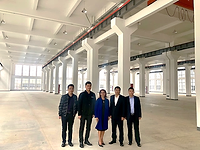Poseidon Sciences Celebrates 20 Years of the Poseidon Dynamic Test System in the Open Sea

The Poseidon Dynamic Test System (PDTS) is a versatile platform that allows exposure of flat panels on a rotating frame in the middle of the sea. This system has been in operation since 2003, and is being used in validation of the performance of hull coatings by dozens of medium-sized and multi-national companies. Supplied with electric power through an underwater cable from the shore laboratory, the motors rotate the panels horizontally at various speeds, ranging from 15 to 25 knots. The erosion rate as result of the fluid shear forces can be determined at each specific speed. 
The figure below shows the velocities experienced by test panels in open sea conditions. PDTS makes it possible to simulate the erosion rate of marine coatings in a moving vessel. This new procedure enables simultaneous evaluation of the erosion rate and bio-fouling at various fluid shear forces using flat panels.

Although static immersion testing is sufficient to measure the anti-fouling characteristics of a particular coating, it is not as reliable in determining the performance of the entire coating system. In many cases, panels that do well under static fail when exposed to shear stress in the PDTS machine. Testing in advance enables reformulation or redesign of the top coat, primer and application procedures to meet customer expectations.
The PDTS was designed by Engr. G. Geocadin and Ms. Araceli Lorella, Director of Research of Athena Biosciences Philippines, a subsidiary of Poseidon Sciences Group. Testing was undertaken in a seawater tank and then shipped by freight to Sacred Heart Marine Research Centre’s (SHMRC) facilities in Tuticorin, Tamil Nadu, India. A floating test platform was built in Tuticorin to carry the PDTS, and final testing was conducted prior to deployment to the sea from SHMRC Beach Laboratories.
Located almost at the southern tip of India, this bay area is predominantly populated by the barnacle, Balanus amphitrite, with seasonal occurrence of plate corals, sponges, hydroids, and bryozoans. Barnacle fouling is year-round because of warm temperatures and low rainfall, making the location a perfect place to study coating performance against biofouling. The marine station is located in Karrapad Cove, which protects the test platforms from waves and currents. It is also in close proximity to the Port of Tuticorin, which is the second busiest port in all of India. Biofouling research has been ongoing at this site for more than 30 years.
SHMRC is a non-governmental research organization established in 1991 based in the city of Tuticorin, which is dedicated to marine biology and marine conservation. The center is recognized for its research on non-toxic compounds to replace those used by the marine coatings industry that pollute the ocean environment. SHMRC’s research is under the direction of Sister Avelin Mary, Ph.D., a Roman Catholic nun belonging to the Congregation of Mother of Sorrows, Servants of Mary.

*All images courtesy of Poseidon Sciences.
Looking for a reprint of this article?
From high-res PDFs to custom plaques, order your copy today!






